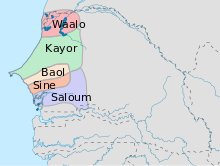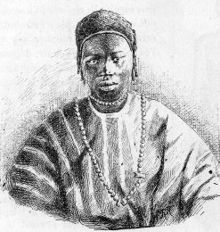Cayor
Kajoor or Cayor was a Wolof state in what is now Senegal , which existed from 1549 to 1902.
history
In 1549 the kingdom of Kajoor became independent from the kingdom of the Wolof with the battle of Danki under the Damel (king) Detie Fu Ndiogu . It became the largest and most powerful of its splits. The capital was Mboul . Waalo lay in the northwest, the rest of the Wolof empire in the east, Baol and Sine in the south .
The Damel von Kajoor also ruled over the Lébou area on Cape Verde and became Teignes (King) of Baol. The office was filled by a four-member council from the Diawdine Bul, the hereditary chief of the Dyambour (free men), the Tchialaw, chief of Dianbagnane, the Botale, chief of Ndiop, and the Badgie, chief of Gategne. Currencies were cowries and gold.
In 1859 a Muslim uprising broke out in Kajoor, which marked the beginning of a civil war that lasted until 1886. Around 1861, the French under Louis Faidherbe drove out the former Geej dynasty and its supporters and installed Maajooojo Faal, who had been the candidate of the rebels in 1859, as the new king. He pledged to adhere to the goals of the Muslim party. Demba War Sall, the leader of the royal slaves of the deposed dynasty, selected the young Muslim Laat Joor from the Geej family as pretender to the throne and waged war against Maajoojoo on his behalf. Between 1861 and 1864, he and the followers of the old Geej dynasty inflicted several humiliating defeats on Maajoojoo. In 1864 the French expelled Laat Joor and his allies from Kajoor. Maajoojo's reign ended during a severe famine in 1865, and the country fell into anarchy . The Muslim community leaders achieved the form of self-government they had sought during the 1859 uprising.
In 1870, supporters of the old Geej dynasty along with Muslim insurgents from Saloum brought Laat Joor to power. In 1875 new fighting broke out when Muslims from neighboring Jolof occupied the country with the support of key segments of the Muslim Party in Kajoor . Laat Joor was able to defeat them with the help of the French, but incurred the permanent hostility of many Muslims through the execution and enslavement of his opponents. In 1875 Amadu Bamba also became an opponent of the monarchy. In 1883 the royal slave Demba War Sall drove out the ruler Laat Joor and initially appointed another ruler.
In 1886 Demba War Sall put himself at the head of the state. He came to terms with French colonial rule and was vigilant to Muslims who threatened his rule. So he proceeded in 1895 against the Murīden . Demba War Sall ruled Kajoor for the French until his death in 1902.
Ruler list
Name of the damel on Wolof:
- Decceefu Njoogu (1549)
- Amari ngoone Sobel
- Maa Sàmba Tàkko
- Ma Xurayja Koli
- Biram Mànga
- Daaw Demba
- Majoor
- Biram Yaasin Buubu
- Décce Maram
- Maa Faali
- Ma Xurayja Kumba Joojo
- Biram Penda Ciloor
- Decce calaw
- Lat Sukaabe
- Maysa Sukaabe
- Maysa Tenda
- Maawo
- Biram Koddu
- Maajoor
- Makoddu
- Biram Faatim Penda
- Amari Ngoone Ndeela Kumba
- Biram Fatma Cub
- Maysa Tenda
- Birima
- Makoddu
- Majoojoo (1861-1865)
- Lat Joor ( Lat Dior , 1870-1883)
- Sàmba Yaasin Faal (1883–1886)
- Demba War Sall (1886-1902)
literature
- James F. Searing: "God alone is King": Islam and Emancipation in Senegal. The Wolof Kingdoms of Kajoor and Bawol, 1859-1914. Heinemann, Portsmouth, 2002.
- Paate sow, Démbi Senegaal: ci làmmeñu Wolof , Dakaar, 1998

